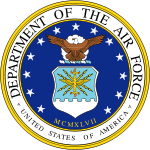Air Force One
| Air Force One | |
|---|---|
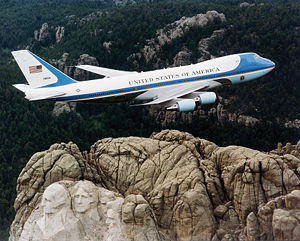 |
|
| A USAF Boeing VC-25A above Mount Rushmore |
Air Force One is the air traffic control call sign of any United States Air Force aircraft carrying the President of the United States.[1] Since 1990, the presidential fleet has consisted of two specifically configured, highly customized Boeing 747-200B series aircraft – tail codes "28000" and "29000" – with Air Force designation "VC-25A". While these aircraft are referred to as "Air Force One" only while the president is on board, the term is commonly used to describe either of the two aircraft normally used and maintained by the U.S. Air Force solely for the president.
Air Force One is a prominent symbol of the American presidency and its power.[2] Air Force One is famous worldwide; it is the most famous, most photographed plane in the world.[3] When then-British Prime Minister Tony Blair indicated a desire for a similar personal air transport, the press immediately dubbed it "Blair Force One."[4][5][6]
Contents |
History
Theodore Roosevelt became the first president to fly in an aircraft on 11 October 1910. At the time he was no longer in office, having been succeeded by William Howard Taft. However, prior to World War II, overseas and cross-country presidential travel was rare. Lack of wireless telecommunication and quick transportation made long-distance travel impractical, as it took up much time and isolated the president from events in Washington, D.C.
By the late 1930s, with the arrival of aircraft such as the Douglas DC-3, increasing numbers of the U.S. public saw passenger air travel as a reasonable mode of transportation. All-metal aircraft, more reliable engines, and new radio aids to navigation had made commercial airline travel safer and more convenient. Life insurance companies even began to offer line pilots insurance policies, albeit at extravagant rates, and many businessmen began using the airlines in preference to rail travel, especially for longer trips.
The first president to fly in an aircraft while in office was Franklin D. Roosevelt, who traveled on a Pan Am-crewed Boeing 314 flying boat to the 1943 Casablanca Conference on the progress of World War II. The threat from the Kriegsmarine's submarines in the Battle of the Atlantic made air travel the preferred method of transportation.
The first dedicated aircraft proposed for presidential carriage was a C-87A VIP transport aircraft. This aircraft, Number 41-24159, was re-modified in 1943 for use as a presidential VIP transport, the Guess Where II, intended to carry President Franklin D. Roosevelt on international trips.[7] Had it been accepted, it would have been the first aircraft to be used in presidential service i.e. the first Air Force One. However, after a review of the C-87's highly controversial safety record in service, the Secret Service flatly refused to approve the Guess Where II for presidential carriage.[7] The plane was then used to transport senior members of the Roosevelt administration on various trips. In March 1944, the Guess Where II transported Eleanor Roosevelt on a goodwill tour of several Latin American countries. The plane was scrapped in 1945.[7]
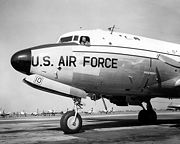
The Secret Service subsequently reconfigured a Douglas C-54 Skymaster for duty as a presidential transport. This aircraft, nicknamed the Sacred Cow, included a sleeping area, radio telephone, and retractable elevator for Roosevelt's wheelchair. As modified, the presidential C-54 carried the president on several important trips.
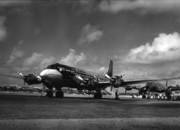
After Roosevelt died in spring 1945, Vice President Harry S Truman became President. He replaced the C-54 in 1947 with a modified C-118 Liftmaster, calling it the Independence, possibly in reference to President Truman's hometown of Independence, Missouri. This was the first aircraft acting as Air Force One that had a distinctive exterior–a bald eagle head painted on its nose.

The presidential call sign was established for security purposes during the administration of Dwight D. Eisenhower. The change stemmed from a 1953 incident where an Eastern Airlines commercial flight (8610) had the same call sign as a flight the president was on (Air Force 8610). The aircraft accidentally entered the same airspace, and after the incident the unique call sign "Air Force One" was introduced for the presidential aircraft.
Eisenhower also introduced four other propeller aircraft, the Lockheed C-121 Constellations (VC-121E) to presidential service. These aircraft were named Columbine II and Columbine III by Mamie Eisenhower after the columbine, the official state flower of Colorado, her adopted home state. Two Aero Commanders were also added to the fleet and earned the distinction of being the smallest Air Force Ones ever. President Eisenhower also upgraded Air Force One's technology by adding an air-to-ground telephone and an air-to-ground teletype machine. Towards the end of Eisenhower's term, in 1958, the Air Force added three Boeing 707 jets (designated SAM 970, 971, and 972), 707-153 models, into the fleet. "Ike" became the first president to use the 707 during his "Flight to Peace" Goodwill tour, from 3 December through 22 December 1959. He visited 11 Asian nations, flying 22,000 miles (35,000 km) in 19 days, about twice as fast as he would have on Columbine.
Boeing 707s as Air Force One

Presidential air travel entered the jet age during the presidency of John F. Kennedy. In October 1962, the Kennedy administration took delivery of a C-137 Stratoliner, a modified long-range 707—Special Air Mission (SAM) 26000, although he had used the Eisenhower-era jets for trips to Canada, France, Austria and the United Kingdom.
The Air Force had attempted a special presidential livery of their own design: a scheme in red and metallic gold, with the nation's name in block letters. Kennedy felt the aircraft appeared too regal and on advice from his wife, First Lady Jacqueline Kennedy, he contacted the French-born American industrial designer Raymond Loewy for help in designing a new livery and interiors for the VC-137 jet.[2] Loewy met with the president, and recorded that his earliest research on the project took him to the National Archives where he looked at the first printed copy of the United States Declaration of Independence, and saw the country's name set widely spaced and in upper case in a typeface called Caslon. He chose to expose the polished aluminum fuselage on the bottom side, and used two blues; a slate-blue associated with the early republic and the presidency, and a more contemporary cyan to represent the present and future. The presidential seal was added to both sides of the fuselage near the nose, a large American flag was painted on the tail, and the sides of the aircraft read UNITED STATES OF AMERICA. The result of Loewy's work won immediate praise from the president, the press, and the jet's livery became a global icon. The VC-137 markings were adapted for the larger VC-25 when it entered service in 1989.
SAM 26000 was in service from 1962 to 1998, serving Presidents Kennedy to Clinton, but was replaced by another VC-137, Special Air Mission 27000 in 1972. Richard Nixon was the first president to use this, and the aircraft would continue serving every president since, until it too was replaced by two VC-25 aircraft (SAM 28000 and 29000) in 1990. SAM 27000 was decommissioned in 2001 by President George W. Bush, flown to San Bernardino International Airport in California, and later driven in pieces to the Ronald Reagan Presidential Library in Simi Valley where it was reassembled and is currently on permanent display.
Transition to Boeing 747s
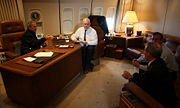
- See also: Boeing VC-25
Though Ronald Reagan's two terms as president saw no major changes to Air Force One, the fabrication of the current 747s began during his presidency. Reagan ordered two identical Boeing 747s to replace the aging 707 that he used for transport.[8] The interior designs were drawn up by First Lady Nancy Reagan, who used designs reminiscent of the American Southwest.[8] The first aircraft was delivered in 1990, during the administration of George H.W. Bush. Delays were experienced to allow for additional work to protect the aircraft from electromagnetic pulse (EMP) effects.

Today's Air Force One is equipped with both secure and unsecure phone and computer communications systems, enabling the president to perform duties while in the air in the event of an attack on the United States.
One of the most dramatic episodes aboard Air Force One happened during the September 11, 2001 attacks. President George W. Bush was interrupted at Emma E. Booker Elementary School in Sarasota, Florida, after the attack on the World Trade Center South Tower in New York City. President Bush flew on Air Force One from Sarasota-Bradenton International Airport to Barksdale Air Force Base in Louisiana and then to Offutt Air Force Base in Nebraska before returning to Washington. The next day, officials at the White House and the Justice Department explained that President Bush did this because there was "specific and credible information that the White House and Air Force One were also intended targets."[9] The White House later could not confirm evidence of a threat made against Air Force One, and subsequent investigation found the original claim to be a result of miscommunication.[10]
Air Force One usually does not have fighter aircraft to escort the presidential aircraft over the United States, but it does occur. On an unscheduled stop in San Antonio, Texas, in January 2006, four fighters were seen in close coverage, within a few meters, two below Air Force One's fuselage, and one under each wing. In June 1974, Syrian fighter jets intercepted Air Force One to act as escorts. However, the Air Force One crew was not informed in advance and, as a result, took evasive action including a dive.[11]
In 2007 U.S. Air Force requested information from Airbus on the A380 as replacement for Air Force One and the C-5 Galaxy based on maintenance costs and fuel efficiency concerns.[12] It is believed the two current aircraft will not need replacement until at least 2020.
Past aircraft that served as Air Force One

Several presidential aircraft that have formerly served as Air Force One are on display in the presidential hangar of the National Museum of the United States Air Force, located at Wright-Patterson AFB near Dayton, Ohio (Sacred Cow, Independence, Columbine III, SAM 26000, and other smaller presidential aircraft), as well as at the Museum of Flight in Seattle, Washington (earlier VC-137B SAM 970). The Boeing 707 that served as Air Force One from the Nixon years to the current George Bush administration (SAM 27000) is on display in Simi Valley, California at the Ronald Reagan Presidential Library. The Library's Air Force One Pavilion was opened to the public on 24 October 2005.
A VC-118A Liftmaster used by John F. Kennedy is on display at the Pima Air & Space Museum in Tucson, Arizona.
United Airlines has the distinction of being the only commercial airline to have operated Executive One, the designation given to a civilian flight on which the U.S. President is aboard. On 26 December 1973, then-President Richard Nixon flew as a passenger aboard a Washington Dulles to Los Angeles flight. It was explained by his staff that this was done in order to conserve fuel by not having to fly the usual Boeing 707 Air Force aircraft.[13]
On 8 March 2000, President Clinton flew to Pakistan aboard an unmarked Gulfstream III while another aircraft with the call sign "Air Force One" flew on the same route a few minutes later.[14][15][16] This diversion was reported by several U.S. press outlets and is not a secret event. This was presumably done as a diversion in case terrorists attempted to shoot down the aircraft that the president was aboard.
See also
- Air Force Two
- Marine One
- Navy One
- Cadillac One
- Executive One
- Air transports of heads of state and government
References
- ↑ Order 7110.65R (Air Traffic Control) Federal Aviation Administration 14 March 2007. Retrieved: 27 August 2007.
- ↑ 2.0 2.1 Walsh, Kenneth T. Air Force One: A History of the Presidents and Their Planes. New York: Hyperion: 2003. ISBN 1-4013-0004-9.
- ↑ Wallace, Chris (host). (2008-11-24). Aboard Air Force One [Television production]. Fox News. Retrieved on 2008-11-28.
- ↑ 'Blair Force One' plans get boost BBC 11 June 2003. Retrieved: 22 April 2007.
- ↑ Tempest, Matthew. "PM to get his own 'Blair Force One'". Guardian Unlimited, 20 June 2006. Retrieved: 22 April 2007.
- ↑ Campbell, Duncan. "Blair Force One cleared for takeoff."Guardian Unlimited, 21 June 2006. Retrieved: 22 April 2007.
- ↑ 7.0 7.1 7.2 Dorr 2002, p. l34.
- ↑ 8.0 8.1 Williams, Rudi (June 10, 2004). "Reagan Makes First, Last Flight in Jet He Ordered". United States Department of Defense. Retrieved on 2008-04-24.
- ↑ White Hose News releases
- ↑ "White House Drops Claim of Threat to Bush." The Washington Post, 27 September 2001. Retrieved: 28 February 2007.
- ↑ Washington Post Book Review of Air Force One: A History of the Presidents and Their Planes. New York: Hyperion: 2003. ISBN 1-4013-0004-9.
- ↑ Trimble, Stephen. "US considers Airbus A380 as Air Force One and potentially a C-5 replacement". Flight Global, 17 October 2007.
- ↑ United Airlines
- ↑ Clinton uses decoy flight for security; Bill Sammon. Washington Times. Washington, D.C.: Mar 26, 2000. pg. C.1.
- ↑ Playing hide-and-seek on trip to Islamabad. Haniffa, Aziz. India Abroad. New York, N.Y.: Mar 31, 2000. Vol. XXX, Iss. 27; pg. 22.
- ↑ Clinton's trip to Asia cost at least $50 million; Milwaukee Journal Sentinel. Milwaukee, Wis.: Apr 9, 2000. pg. 175.A
Further reading
- Abbott James A. and Elaine M. Rice. Designing Camelot: The Kennedy White House Restoration. New York: Van Nostrand Reinhold, 1998. ISBN 0-442-02532-7.
- Albertazzie, Ralph and Jerald F. TerHorst. Flying White House: The Story of Air Force One. New York: Book Sales, 1979. ISBN 0-698-10930-9.
- Braun, David. Q&A: U.S. Presidential Jet Air Force One. National Geographic News, 29 May 2003
- Dorr, Robert F. Air Force One. St. Paul, Minnesota: Motorbooks International, 2002. ISBN 0-7603-1055-6.
- Hardesty, Von. Air Force One: The Aircraft that Shaped the Modern Presidency. Chanhassen, Minnesota: Northword Press, 2003. ISBN 1-55971-894-3.
- Harris, Tom. How Air Force One Works. HowStuffWorks.com. Retrieved: 10 October 2006.
- Technical Order 00-105E-9, Segment 9, Chapter 7 Technical Order 00-105E-9
- Walsh, Kenneth T. Air Force One: A History of the Presidents and Their Planes. New York: Hyperion: 2003. ISBN 1-4013-0004-9.
External links
- SAM 26000 at the National Museum of the United States Air Force
- Facts and History of 707 as Air Force One and "Where they are Now?"
- Air Force One Pavilion
- Air Force Fact Sheet, VC-25 - AIR FORCE ONE
- Air Force One page on White House site
- Truman Library & Museum
- United States Air Force
- Boeing History of Air Force One
|
|||||||||||
|
|||||
|
|||||||||||||||||||||||||||||||||||||
|
||||||||||||||
